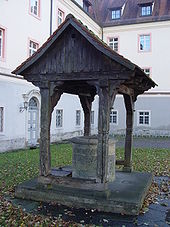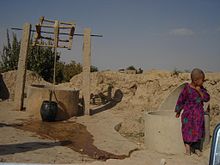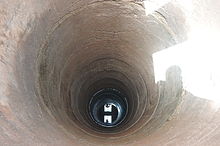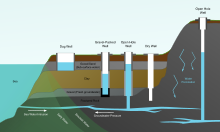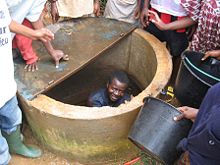- Water well
-
"Village pump" redirects here. For information on Wikipedia project-related discussions see Wikipedia:Village pump.
A water well is an excavation or structure created in the ground by digging, driving, boring or drilling to access groundwater in underground aquifers. The well water is drawn by an electric submersible pump, a trash pump, a vertical turbine pump, a handpump or a mechanical pump (e.g. from a water-pumping windmill[1]). It can also be drawn up using containers, such as buckets, that are raised mechanically or by hand.
Wells can vary greatly in depth, water volume and water quality. Well water typically contains more minerals in solution than surface water and may require treatment to soften the water by removing minerals such as arsenic, iron and manganese.
Contents
Types of water wells
Dug wells
Until recent centuries, all artificial wells were pumpless hand-dug wells of varying degrees of formality, and they remain a very important source of potable water in some rural developing areas where they are routinely dug and used today. Their indispensability has produced a number of literary references, literal and figurative, to them, including the Christian Bible story of Jesus meeting a woman at Jacob's well (John 4:6) and the "Ding Dong Bell" nursery rhyme about a cat in a well.
Hand-dug wells are excavations with diameters large enough to accommodate one or more men with shovels digging down to below the water table. They can be lined with laid stones or brick; extending this lining upwards above the ground surface into a wall around the well serves to reduce both contamination and injuries by falling into the well. A more modern method called caissoning uses reinforced concrete or plain concrete pre-cast well rings that are lowered into the hole. A well-digging team digs under a cutting ring and the well column slowly sinks into the aquifer, whilst protecting the team from collapse of the well bore.
Hand dug wells provide a cheap and low-tech solution to accessing groundwater in rural locations in developing countries, and may be built with a high degree of community participation, or by local entrepreneurs who specialize in hand-dug wells. Hand dug wells have been successfully excavated to 60 metres (200 ft). Hand dug wells are inexpensive and low tech (compared to drilling) as they use mostly hand labour for construction. Hand dug wells have low operational and maintenance costs, in part because water can be extracted by hand bailing, without a pump. Hand dug wells can be easily deepened, which may be necessary if the ground water level drops, by telescoping the lining further down into the aquifer. The yield of existing hand dug wells may be improved by deepening or introducing vertical tunnels or perforated pipes.
Drawbacks to hand-dug wells are numerous. It can be impractical to hand dig wells in areas where hard rock is present, and they can be time-consuming to dig and line even in favorable areas. Because they exploit shallow aquifers, the well may be susceptible to yield fluctuations and possible contamination from surface water, including sewage. Hand dug well construction generally requires the use of a trained well construction team, and the capital investment for equipment such as concrete ring moulds, heavy lifting equipment, well shaft formwork, motorized de-watering pumps, and fuel can be large for people in developing countries. Construction of hand dug wells can be dangerous due to collapse of the well bore, falling objects and asphyxiation, including from dewatering pump exhaust fumes.
Woodingdean well, hand-dug between 1858 and 1862, is claimed to be the world's deepest hand-dug well at 1,285 feet (392 m).[2] The Big Well in Greensburg, Kansas is billed as the world's largest hand-dug well, at 109 feet (33 m) deep and 32 feet (9.8 m) in diameter. However, the Well of Joseph in the Cairo Citadel at 280 feet (85 m) deep and the Pozzo di S. Patrizio (St. Patrick's Well) built in 1527 in Orvieto, Italy, at 61 metres (200 ft) deep by 13 metres (43 ft) wide[3] are both larger by volume.
Driven wells
Driven wells may be very simply created in unconsolidated material with a "well point", which consists of a hardened drive point and a screen (perforated pipe). The point is simply hammered into the ground, usually with a tripod and "driver", with pipe sections added as needed. A driver is a weighted pipe that slides over the pipe being driven and is repeatedly dropped on it. When groundwater is encountered, the well is washed of sediment and a pump installed.
Drilled wells
 Cable tool water well drilling rig in Kimball, West Virginia, USA.
Cable tool water well drilling rig in Kimball, West Virginia, USA.
Drilled wells can be excavated by simple hand drilling methods (augering, sludging, jetting, driving, hand percussion) or machine drilling (rotary, percussion, down the hole hammer). Drilled wells can get water from a much deeper level than can dug wells - often up to several hundred metres.
Drilled wells with electric pumps are currently used throughout the world, typically in rural or sparsely populated areas, though many urban areas are supplied partly by municipal wells.
Drilled wells are typically created using either top-head rotary style, table rotary, or cable tool drilling machines, all of which use drilling stems that are turned to create a cutting action in the formation, hence the term 'drilling'. Most shallow well drilling machines are mounted on large trucks, trailers, or tracked vehicle carriages. Water wells typically range from 3 to 18 m deep, but in some areas can go deeper than 900 m.
Rotary drilling machines use a segmented steel drilling string, typically made up of 6 m sections of galvanized steel tubing that are threaded together, with a bit or other drilling device at the bottom end. Some rotary drilling machines are designed to install (by driving or drilling) a steel casing into the well in conjunction with the drilling of the actual bore hole. Air and/or water is used as a circulation fluid to displace cuttings and cool bits during the drilling. Another form of rotary style drilling, termed 'mud rotary', makes use of a specially made mud, or drilling fluid, which is constantly being altered during the drill so that it can consistently create enough hydraulic pressure to hold the side walls of the bore hole open, regardless of the presence of a casing in the well. Typically, boreholes drilled into solid rock are not cased until after the drilling process is completed, regardless of the machinery used.
The oldest form of drilling machinery is the Cable Tool, still used today. Specifically designed to raise and lower a bit into the bore hole, the 'spudding' of the drill causes the bit to be raised and dropped onto the bottom of the hole, and the design of the cable causes the bit to twist at approximately ¼ revolution per drop, thereby creating a drilling action. Unlike rotary drilling, cable tool drilling requires the drilling action to be stopped so that the bore hole can be bailed or emptied of drilled cuttings.
Drilled wells are usually cased with a factory-made pipe, typically steel (in air rotary or cable tool drilling) or plastic/PVC (in mud rotary wells, also present in wells drilled into solid rock). The casing is constructed by welding, either chemically or thermodynamically, segments of casing together. If the casing is installed during the drilling, most drills will drive the casing into the ground as the bore hole advances, while some newer machines will actually allow for the casing to be rotated and drilled into the formation in a similar manner as the bit advancing just below. PVC or plastic is typically welded and then lowered into the drilled well, vertically stacked with their ends nested and either glued or splined together. The sections of casing are usually 6 m or more in length, and 6 to 12 in (15 to 30 cm) in diameter, depending on the intended use of the well and local groundwater conditions.
Surface contamination of wells in the United States is typically controlled by the use of a 'surface seal'. A large hole is drilled to a predetermined depth or to a confining formation (clay or bedrock, for example), and then a smaller hole for the well is completed from that point forward. The well is typically cased from the surface down into the smaller hole with a casing that is the same diameter as that hole. The annular space between the large bore hole and the smaller casing is filled with bentonite clay, concrete, or other sealant material. This creates an impermeable seal from the surface to the next confining layer that keeps contaminants from traveling down the outer sidewalls of the casing or borehole and into the aquifer. In addition, wells are typically capped with either an engineered well cap or seal that vents air through a screen into the well, but keeps insects, small animals, and unauthorized persons from accessing the well.
At the bottom of wells, based on formation, a screening device, filter pack, slotted casing, or open bore hole is left to allow the flow of water into the well. Constructed screens are typically used in unconsolidated formations (sands, gravels, etc.), allowing water and a percentage of the formation to pass through the screen. Allowing some material to pass through creates a large area filter out of the rest of the formation, as the amount of material present to pass into the well slowly decreases and is removed from the well. Rock wells are typically cased with a PVC liner/casing and screen or slotted casing at the bottom, this is mostly present just to keep rocks from entering the pump assembly. Some wells utilize a 'filter pack' method, where an undersized screen or slotted casing is placed inside the well and a filter medium is packed around the screen, between the screen and the borehole or casing. This allows the water to be filtered of unwanted materials before entering the well and pumping zone.
Classification
There are two broad classes of drilled-well types, based on the type of aquifer the well is in:
- Shallow or unconfined wells are completed in the uppermost saturated aquifer at that location (the upper unconfined aquifer).
- Deep or confined wells are sunk through an impermeable stratum into an aquifer that is sandwiched between two impermeable strata (aquitards or aquicludes). The majority of deep aquifers are classified as artesian because the hydraulic head in a confined well is higher than the level of the top of the aquifer. If the hydraulic head in a confined well is higher than the land surface it is a "flowing" artesian well (named after Artois in France).
Two additional broad classes of well types may be distinguished, based on the use of the well:
- production or pumping wells, are large diameter (greater than 15 cm in diameter) cased (metal, plastic, or concrete) water wells, constructed for extracting water from the aquifer by a pump (if the well is not artesian).
- monitoring wells or piezometers, are often smaller diameter wells used to monitor the hydraulic head or sample the groundwater for chemical constituents. Piezometers are monitoring wells completed over a very short section of aquifer. Monitoring wells can also be completed at multiple levels, allowing discrete samples or measurements to be made at different vertical elevations at the same map location.
Obviously, a well constructed for pumping groundwater can be used passively as a monitoring well and a small diameter well can be pumped, but this distinction by use is common.
Siting
Before excavation, information about the geology, water table depth, seasonal fluctuations, recharge area and rate must be found. This work is typically done by a hydrogeologist, or a groundwater surveyor using a variety of tools including electro-seismic surveying,[4] any available information from nearby wells, geologic maps sometimes geophysical imaging.
Contamination
Shallow pumping wells can often supply drinking water at a very low cost, but because impurities from the surface easily reach shallow sources, a greater risk of contamination occurs for these wells when they are compared to deeper wells. Dug and driven wells are relatively easy to contaminate, and dug wells are unreliable in most of the U.S.[5]
The quality of the well water can be significantly increased by lining the well, sealing the well head, fitting a self-priming hand pump, constructing an apron, ensuring the area is kept clean and free from stagnant water and animals, moving sources of contamination (latrines, garbage pits) and carrying out hygiene education. The well should be cleaned with 1% chlorine solution after construction and periodically every 6 months.
Microorganisms
Most of the bacteria, viruses, parasites, and fungi that contaminate well water comes from fecal material from humans and other animals. Common bacterial contaminants include E. coli, Salmonella, Shigella, and Campylobacter jejuni. Common viral contaminants include norovirus, sapovirus, rotavirus, enteroviruses, and hepatitis A and E. Parasites include Giardia lamblia, Cryptosporidium, Cyclospora cayetanensis, and microsporidia.[5]
Chemicals
Chemical contamination is a common problem with groundwater. Nitrates from sewage or fertilizer are a particular problem for children. Pollutant chemicals include pesticides and volatile organic compounds from gasoline, dry-cleaning, the fuel additive methyl tert-butyl ether (MTBE), and perchlorate from rocket fuel, airbag inflators, and other artificial and natural sources.
Several minerals are also contaminants, including lead leached from brass fittings or old lead pipes, chromium VI from electroplating and other sources, naturally occurring arsenic, radon, and uranium—all of which can cause cancer—and naturally occurring fluoride, which is desirable in low quantities to prevent tooth decay, but can cause dental fluorosis in higher concentrations.[5]
Some chemicals are commonly present in water wells at levels that are not toxic, but can cause other problems. Calcium and magnesium cause what is known as hard water, which can precipitate and clog pipes or burn out water heaters. Iron and manganese can appear as dark flecks that stain clothing and plumbing, and can promote the growth of iron and manganese bacteria that can form slimy black colonies that clog pipes.[5]
Mitigation
Cleanup of contaminated groundwater tends to be very costly. Effective remediation of groundwater is generally very difficult.
Contamination of groundwater from surface and subsurface sources can usually be dramatically reduced by correctly centering the casing during construction and filling the casing annulus with an appropriate sealing material. The sealing material (grout) should be placed from immediately above the production zone back to surface, because, in the absence of a correctly constructed casing seal, contaminated fluid can travel into the well through the casing annulus. Centering devices are important (usually 1 per length of casing or at maximum intervals of 9 m) to ensure that the grouted annular space is of even thickness. Upon the construction of a new test well, it is considered best practice to invest in a complete battery of chemical and biological tests on the well water in question. Point-of-use treatment is available for individual properties and treatment plants are often constructed for municipal water supplies that suffer from contamination. Most of these treatment methods involve the filtration of the contaminants of concern, and additional protection may be garnered by installing well-casing screens only at depths where contamination is not present.
Well water for personal use is often filtered with reverse osmosis water processors; this process can remove very small particles. A simple, effective way of killing microorganisms is to bring the water to a full boil for one to three minutes, depending on location. A household well contaminated by microorganisms can initially be treated by shock chlorination using bleach, generating concentrations hundreds of times greater than found in community water systems; however, this will not fix any structural problems that led to the contamination and generally requires some expertise and testing for effective application.[5]
Environmental problems
A risk with the placement of water wells is soil salination. This problem occurs when the watertable of the soil begins to drop and salt begins to accumulate as the soil begins to dry out.[6] Another environmental problem that is very prevalent in water well drilling is the potential for methane to seep through.
Soil salination
The potential for soil salination is a large risk when choosing the placement of water wells. Soil salination is caused when the water table of the soil drops over time and salt begins to accumulate. In turn, the increased amount of salt begins to dry the soil out. This is a very detrimental problem because the increased level of salt in the soil can result in the degradation of soil and can be very harmful to vegetation.
Methane
Methane, an asphyxiate, is a chemical compound that is the main component of natural gas. When methane mixes with oxygen, it has the ability to reduce oxygen to harmfully low levels in a small space or to form an explosion. This explosive quality is what poses such a danger in regards to the drilling and placement of water wells.
Low levels of methane in drinking water are not considered toxic. When methane seeps into a water supply, it is commonly referred to as "methane migration." This can be caused by old natural gas wells near water well systems becoming abandoned and no longer monitored.
Ancient well technologies
Further information: History of water supply and sanitation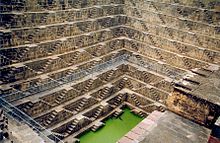 Chand Baori, a stepwell built in the 9th century.
Chand Baori, a stepwell built in the 9th century.
The earliest wells are known from the Neolithic. In the submerged Pre-Pottery Neolithic B settlement of Atlit Yam in Israel, dated to 8100–7500 BC, a well has been found, which so far is the oldest known. Other PPNB wells (7–8 m deep) are known from Kissonerga-Mylouthkia on Cyprus and maybe shallower examples from Shillourokambos as well.[7]
Wood-lined wells are known from the early Neolithic Linear Pottery culture, for example in Kückhoven, dated 5090 BC and Eythra, dated 5200 BC in Germany and Schletz in Austria. The early Mesolithic site of Friesack in Germany has yielded a shallow pit with the remains of a birch-bark container that may have been a shallow artificial well.
Australian Aborigines relied on wells to survive the harsh Australian desert. They would dig down, scooping out sand and mud to reach clean water, then cover the source with spinifex to prevent spoilage. Non-aborigines call these native wells, soaks or soakages.
Stepwells are common in the west of India. In these wells, the water may be reached by descending a set of steps. They may be covered and are often of architectural significance. Many stepwells were also used for leisure, providing relief from the daytime heat.
 A qanat.
A qanat.
A qanat is an ancient water collection system made up of a series of wells and linked underground water channels that collects flowing water from a source usually a distance away, stores it, and then brings the water to the surface using gravity. Much of the population of Iran and other arid countries in Asia and North Africa historically depended upon the water from qanats; the areas of population corresponded closely to the areas where qanats are possible.
In Egypt, shadoofs and sakiehs are used.[8][9] When compared to each other however, the Sakkieh is much more efficient, as it can bring up water from a depth of 10 meters (versus the 3 meters of the shadoof). The Sakieh is the Egyptian version of the Noria.
From the Iron Age onwards, wells are common archaeological features, both with wooden shafts and shaft linings made from wickerwork.
Lately, however, the described wells/pumps are no longer very efficient and can be replaced by either handpumps or treadle pumps. Another alternative is the use of self-dug wells, electrical deep-well pumps (for higher depths). Appropriate technology organizations as Practical Action are now supplying information on how to build/set-up (diy) handpumps and treadle pumps in practice.[10][11]
Cultural references
See also: Wells in the Bible Water use, tacuinum sanitatis casanatensis (14th century)
Water use, tacuinum sanitatis casanatensis (14th century)
Springs and wells have had cultural significance since prehistoric times, leading to the foundation of towns such as Wells and Bath in Somerset. Interest in health benefits led to the growth of spa towns including many with wells in their name, examples being Llandrindod Wells and Royal Tunbridge Wells.
Empty wells are a prominent element in some of the work of Japanese author Haruki Murakami, especially The Wind-Up Bird Chronicle.
In Lewis Carroll's Alice in Wonderland, chapter 7, The Dormouse tells the history of a family who lived "at the bottom of a well", made of treacle (see treacle mining).
There is a belief that a wish can be made in a well; see wishing well. There is much folklore in Wales surrounding wells, particularly in relation to their healing properties. In Scotland and Ireland, there is a Celtic tradition of leaving cloth offerings for healing at Clootie wells. In the Peak District of England, a tradition of Well dressing has persisted from Pagan to Christian religion, possibly related to plague.
Eratosthenes first calculated the radius of the Earth in about 230 BC by comparing shadows in wells during the summer solstice.[12]
In Western Ukraine, water wells were traditionally centers of social life, and the community came together to build them using a traditional process. Local stories often emphasize the social and cultural values of wells. The wells were decorated and had a wooden wheel attached to raise the bucket. Wells are still used in many Ukrainian towns and cities.
The same is true with the early Israelites, as depicted in the Hebrew Bible and in the Christian New Testament. Many Bible stories take place around wells, such as the finding of a wife for Isaac in Genesis and Jesus's talk with the Samaritan woman in the Gospels.
In the novel Ring by Koji Suzuki, and subsequent film adaptations, the malevolent antagonist, Sadako Yamamura, is revealed to have been killed and thrown into a well some thirty years before the events of the novel. Sadako's well is a recurring theme in the story, especially in the 1998 film adaptation.
In an album called Märchen by Japanese band Sound Horizon, a well plays an important part as a reference to id. Ido (イド), as written in the booklet, can be read as "well" or "id".
See also
- Baptist well drilling
- Drainage by wells
Notes
- ^ DIY waterpumping windmill for the developing world
- ^ "Woodingdean Well". 2005. http://www.mybrightonandhove.org.uk/page_id__6948_path__0p115p1224p597p.aspx. Retrieved 26 jan 2010.
- ^ St. Patrick's Well
- ^ Du Preez, Michael. "ELECTRO-SEISMIC SURVEYS APPLIED TO MODDELING OF GROUNDWATER FLOW SYSTEMS". Bloemfontein, South Africa. http://aquamap.co.nz/uploads/pdfs/ELECTRO-SEISMIC%20SURVEYS%20APPLIED%20TO%20MODELING%20OF%20GROUNDWATER%20FLOW.pdf. Retrieved 21 April 2011.
- ^ a b c d e Committee on Environmental Health; Committee on Infectious Diseases (2009). "Drinking water from private wells and risks to children". Pediatrics 123 (6): 1599–1605. doi:10.1542/peds.2009-0751. PMID 19482772.
- ^ Soil salination by placement of water wells mentioned in India
- ^ http://www.straitstimes.com/Breaking+News/Tech+and+Science/Story/STIStory_394409.html
- ^ Sakieh explication/difference vs Sakia
- ^ Sakia explication
- ^ Practical Answers – Handpumps
- ^ Treadle pump
- ^ [1][dead link]
References
- Driscoll, F. (1986). Groundwater and Wells. St. Paul: Johnson Filtration Systems. ISBN 978-0-9616456-0-1.
External links
- Wellowner.org
- U.S. Centers for Disease Control and Prevention (CDC) Healthy Water - Water Wells Site covering well basics, guidelines for proper siting and location of wells to avoid contamination, well testing, diseases related to wells, emergency well treatment and other topics.
- US Geological Survey – Ground water: Wells
- US Geological Survey – Water Science Pictures Flowing Artesian Well
- American Ground Water Trust
- National Ground Water Association
- Lifewater International Technical Library
- The Internet Sacred Texts Archive: The Folklore of Wells (Wales)
- Driving a well with a well point
- Well Construction Technical Resources for NGOs
- The Techniques and Tools of the Kazusabori (上総掘り) Well-boring
- Restoring a Flooded Well to Service, G. Morgan Powell, Kansas State University, June 2006
- Equations for drainage by wells: [2]
- Software for drainage by wells: [3]
- Water Wells drilled in Ireland
Topics in geotechnical engineering Soils Soil properties Soil mechanics Geotechnical investigation Cone penetration test · Standard penetration test · Exploration geophysics · Monitoring well · BoreholeLaboratory tests Field tests Foundations Bearing capacity · Shallow foundation · Deep foundation · Dynamic load testing · Pile integrity test · Wave equation analysis · Statnamic load testRetaining walls Slope stability Earthquakes Geosynthetics Instrumentation for Stability Monitoring Categories:- Water wells
- Water supply infrastructure
- Archaeological features
Wikimedia Foundation. 2010.

